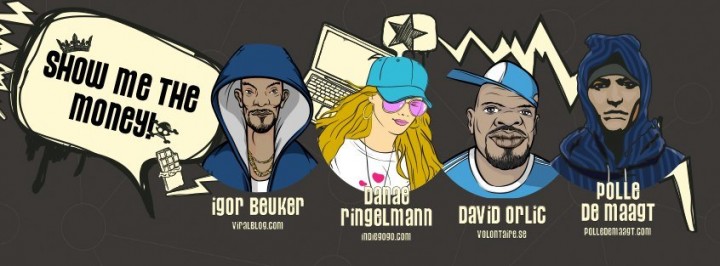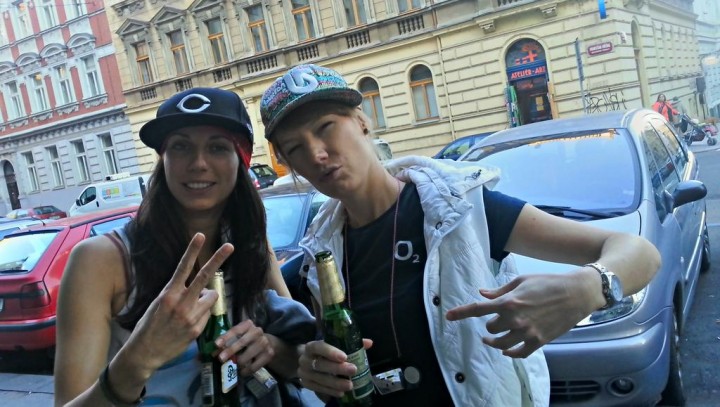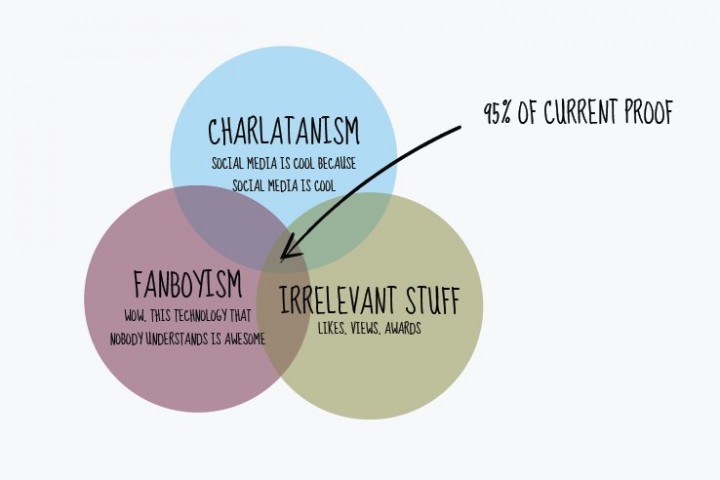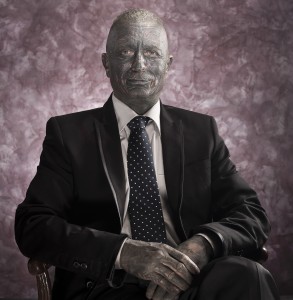This has been the third year of Social Marketers Summit in Prague and again, it was definitely worth attending! An interesting mix of foreign and local speakers was given a common topic: Show me the money. A penny earned, a penny saved, a penny gained in satisfaction. Did you miss it? Never mind, I have summed up what it was all about. And special thanks to organizers for a “blogger priced ticket” – I hope you don’t mind the fact it took me a while to finish this article!
The whole summit took place in Bio Oko, an independent cinema that often hosts various events. In my opinion, the Lucerna cinema last year was a bit more representative. The only problem with the space, however, was the lack of sockets. This year Social Summit Prague used hip-hop styling. The presenters, Pavel Hacker (@Rattle7) and Vojta Bednář (@tyinternety) entered with a blast and the whole show could start. So what could you learn and whom could you meet?
The speaker that was supposed to start off – Igor Beuker (@IgorBeuker), ViralBlog founder who had made a huge impression last year – couldn‘t come due to a scooter crash that kept him at home! So instead the tough role of being the first speaker was given to one of the two ladies among the speakers: Danae Ringelmann (@GoGoDanae), cofounder of Indiegogo. The site is one of the leading crowd-funding platforms and – in contrast to probably the most famous crowd-sourcing site KickStarter – projects keep the money even if they don’t reach the targeted sum.
Danae (read more about her background in FastCompany profile) reminded us that crowd-funding is nothing new (in the Czech Republic we have our national theatre crowd-funded, in the USA this model was used for the pedestal of the Statue of Liberty). But the internet and social networks (and easy on-line payments) have made it available for a much larger public than ever before.
I believe that the current situation where artists are often the most successful organizers of crowd funding projects (along with video game developers) will soon shift towards more “serious” business. Danae spoke of different sorts of projects: Causes (charity stuff, including these crazy toilet paper guys), Artists (movies and video games are quite popular) and Entrepreneurs (from 3D printers to a crazy insect eradication device called Bug-A-Salt that raised over USD 500k while asking for 15k). However, quite recently the most successful campaign in terms of the final sum raised was Let’s Build a Goddamn Tesla Museum run by the infamous cartoon artist Matthew Inman aka The Oatmeal. In August 2012 he joined forces with a non-profit group The Tesla Science Center at Wardenclyffe to raise money in order to preserve the Wardenclyffe facility as a science center and museum. The project reached its goal of raising $850,000 within a week and in the end more than $1,370,000 was raised.
It seemed that the summit audience is more familiar with Kickstarter, I was probably one of the few people who already donated through IndieGoGo: three bucks on Tesla and fifty dollars for a postcard from South America sent by TransTrabant expedition, where David “Havran” Spáčil – see the Videoflot interview I made with him – acts as one of the filmmakers.
I have asked Danae about the “success rate“, but as IndieGoGo (unlike Kickstarter) offers the “Keep it all“ (no matter whether the project goal is met or not, the funds collected are handed over to the entrepreneur) model, you don‘t have to succeed. She said many projects fail to raise anything, but that is usually a lesson learned too – and it signals to the creators of the campaign, that they have a problem. And that’s good to know sooner rather than later.
Btw, in the Czech Republic there are several crowd-funding platforms: Fondom.at and Nakopni.me are in my opinion better in getting PR than getting projects funded; KreativciSobe.cz has already helped to realize three books and one short film.
The next presentation was given by Polle de Maagt. And I fully agree with Dušan Šimonovič who made it clear: “So @Polledemaagt have made the #smsprague worth the money before 11AM. #restekpa and thx for inspiration!“ It was great to see that a top league player (Polle works for the biggest brands – KLM, ING, Ikea, Starbucks) shares my mindset. He introduced his motto at the beginning: I change companies to be less about ads and more about acts. Two years ago, he was the guy behind the oh-so-famous KLMSurprise campaign.
This campaign generated more than a million impressions – but I always felt a bit of unease with it. So having Polle in front of me, I asked “Isn’t it a bit fake? You pleased a couple of tens of passengers and gained a massive amount of positive reactions… But what does it say about an average person and their customer experience?” It seemed Polle was just in need of this question – the next slide he showed was titled: Dude, where’s my suitcase? KLM moved on from campaigns, albeit very successful campaigns, to 24/7 customer care (7 languages, 25k interactions per week). So it comes as no surprise that they ranked as No. 1 in SocialBakers list of Socially Devoted Global Brands (summer 2012). And KLM is also very good in showing the ROI: their TripPlanner has been break-even after the first month, so was the funny concept of Travel Predictions. You let the FB app gather your profile data and it predicts where are you going to travel (and with which of your friends) – plus it of course gives you the chance to book the tickets straight away.
KLM is a traditional company and ROI orientated one. I love Polle’s slide about “social media reasoning” (he allowed me to share it).
If you mean it seriously, you have to talk to people that don’t give a damn about your likes and that are not impressed by fancy gadgets. So you have to stop talking bullshit bingo, and start talking Excel. Show them the money. Introduce an example of an angry VIP that was turned into a happy brand advocate using social tools. Integrate – so that not only marketing, but many other departments get involved. Learn about the company KPIs and focus your social media program on it. Explain to the execs that PR people do actually believe in the social cases you feed them with and that it can bring an enormous coverage if done right. OK, enough said. Just go and check out Polle’s SlideShare too.
The first session ended with Tom Čupr (@tomcuprcz), founder of Slevomat (the Czech word for Groupon-like style of shopping and the No. 1 project of this kind in Central Europe). Tomáš Čupr shared some real numbers and experience. The whole “Slevomat Group“ earned more than 60M Euros in 2011 and Facebook has been a huge traffic source for them since the very beginning (one of the most successful Czech FB apps – all time – was the Slevomat Wheel of Fortune, where you can push the wheel and earn some credits, which was automatically shared on your wall: extremely simple, and still extremely successful).
The main Slevomat page has almost 200k fans plus they have many smaller, local ones. Tom started debunking myths from his first words. Engagement? Well… When you want the engagement, just go ahead and post photos. But if you care more about the traffic, post links that will lead people to your site. A gallery full of luxury underwear generated many likes, but not sales. Slevomat extensively uses promoted posts and based on their statistics, links bring most sales – and these are clicks from non-fans! They also play with the Power Editor and a lot with targeting (so they were able to target runners with sporty shoes very well). They keep the social in-house and they have a very good ratio on FB ads sales – but I was wondering whether the time spent on the campaigns is worth the “opportunity” (other channels generate much higher numbers). Though Tom’s focus was sales, he also values the feedback they gain from social networks. One of his sayings might have the chance to become famous: Engagement is the luxury for big brands.
And the next presentation was exactly about engagement and big brands. A topic for Jan Řežáb (@janrezab) from SocialBakers. The other Czech speakers spoke Czech, but Jan‘s presentation was of course in English. He came back from NYC, where SocialBakers held the Engage conference. The main message is self-evident from the title: companies should do whatever it takes to engage in the dialogue. The situation has improved a lot over the last year or two with companies reacting to queries, posting more interesting and valuable content that is getting shared by the audience… But the competition has been rising too. While an average brand used to post maybe twice a week, now the best performing marketers post on a daily basis (five times more than a year ago on average), the number of liked pages has risen steeply too. Jan advised the companies to use pictures and videos, to avoid posting again when the previous post is still “alive” (getting reactions) and to watch the competitors.
In the light of recent changes to the Edgerank algorithm and the drop in the organic reach – confirmed by SocialBakers themselves, see their TechCrunch article prepared together with We Are Social called Facebook has decreased Page Reach and here’s why – it was interesting to see the head of Socialbakers disagreeing with the common knowledge of social marketers “Facebook wants us to pay to get to the audience”. The rants came from various sources (read Geoffrey Colon / Ogilvy or Jeff Doak) and the industry seems to be really annoyed this time, as probably they seem to finally understand the numbers (the fact that more fans = smaller chance to get most of them, was a big surprise to many for a really long time).
My personal comment: if this helps companies to understand that they should focus on active fans, I’m all in. I just wonder whether FB is aware of the vast shades of gray where high school students built empires of “fun fan pages” to sell the FB traffic to brands – and what are they going to do with it.
Jan’s grand finale was the introduction of social video reports. I totally applaud the smart guys in Socialbakers that understand the power of visual reports – creating an automated tool that spills out a piece of video with your most successful posts, with pie charts showing that you’re ahead of your competitors and that you’re doing better than a month ago – this will have huge success among management boards all over the world. To me, it’s a top notch example of bullshitting, but I’m a lucky person since I don’t need this to convince my clients that they should care about social media. And I know in most companies, this can help the social media managers a lot. And it will surely be a great business for SocialBakers.
The next speaker didn‘t leave much of an impression among the audience (as seen in the Twitter feed with #smsprague hashtag). I think it’s a pity, since Petr Šimeček from Keboola – unlike Jan – actually really works with the data to find the money. But that’s a much tougher issue, one that cannot be represented by automated video reports. Keboola is a Gooddata partner and they can help you to connect different data: from web services, through traffic reports, internal databases to social networks. If you have projects robust enough (and of course money to afford it – this really isn’t SMB service), they can get well behind the obvious stuff and find the hidden connections and relations. This isn’t easy and sexy, but potentially, the money earned can be surprisingly high.
Which leads us to the last morning speaker: Jan Egem from KBMG Czech Republic didn’t show where the money is – he showed where the money isn’t. You’ve got all the engagement? Like Ford had with their very successful campaign designed primarily for the Czech market called “Zlatý ručičky“ – you can watch the promo video from Wundermann agency below.
So far, so good – but the sales of new Fords were a big disappointment. A long story short: you have to have a product that fits the audience.
After the lunch we got to the next case that represented… A country. David Orlic (@davidorlic, a creative director from the Volontaire agency) presented a famous case of a Twitter account simply called @sweden. The aim of the account is to promote Sweden as a progressive country that is so democratic that it lets its citizens run the country’s official Twitter account. Week by week, Curators of Sweden (very different individuals from Sweden) are given the account and they tweet whatever they want. Really. Even if it is not carefully crafted and in line with a PR strategy .
And you bet it isn’t. The third ever tweet sent during the project was: “Listen up, folks! I’m @kwasbeb, a regular swedish dude, and I’m taking over this goddamned account for a week! Expect bad sex and slapstick.” Well, these are probably not the words any usual PR campaign would use.
David Orlic also mentioned the next big problem – criticism of Swedish ministers (now the curators use a special hashtag #myownopinion to highlight the fact they are expressing their own opinions when tweeting about politics). But the most controversial issue took place in June this year, when Sonja Abrahamsson (@hejsonja) tackled an issue that stirred a fierce controversy when she tweeted:
Whats the fuzz with jews. You can’t even see if a person is a jew, unless you see their penises, and even if you do, you can’t be sure!?
She continued in a couple of tweets and many US based media / personalities called it a scandal. Usually not really having thought about what they saw, since when you read the whole story, you simply have to agree with Paul Widen (a Swedish Jew) who wrote an article for The Times of Israel, showing she might be ignorant, but definitely not anti-Semitic. But the best part was the reaction of VisitSweden.com (the agency that funds the whole project) – they faced the criticism, explained the idea behind the project and refused to delete the tweets or apologize for them (especially since Sonja wrote that she’s sorry if somebody finds her tweets offensive).
Even though the presentation was rather about PR and branding, the money part is hidden in the publicity the account got all over the world. I’d say that it was mostly for the controversy, though in my opinion a bit “fake controversy” – I doubt the account would ever be given to, let’s say, members of Svenskarnas Parti (Party of Swedes – a extreme right wing political party in Sweden). The publicity is claimed to be worth 40M USD (the budget 100k USD) – but as you might already guess: this is the trophy for the originality, so it cannot be copied and the reasoning behind 40M is a bit vague too.
Next on stage came Jas Dhaliwal (@jas – what a cool Twitter handle!) – London based boss of social media for AVG, an antivirus company originally from the Czech Republic. I hope I will have the chance to introduce a more detailed profile of him since we are planning to conduct an interview. However, the focus of his presentation was Customer Care. Users tend to use social media instead of call centers as they feel it gives them more power against the brands in conflict resolution. Companies that decide to undertake the often painful way of communicating with their customers through social media – in terms of customer care – can on the other hand sometimes see the great results it can bring. Because a pleased customer might become the best ambassador and with a great product, you can create a great community – and the community helps the company to scale as it takes some load off the company itself.
AVG is an example, with their volunteers helping other customers and being advocates of the brand on other forums. You can see the side effects on Jas’ LinkedIn profile – the words of praise for his dedication unleash the bottom line: a great product also needs a great team to shine. So I find it as no coincidence that AVG was listed in SB 100 Report by BrandWatch as No. 15 overall and No. 2 in technology (only after Dell, which was No. 1 in general). I hope to share more of Jas’ insights in an incoming article!
After serious Jas, it was time for a relaxing kind of presentation. Alena Oswaldová (@blondyna) from O2 and Lenka Černá (@lenka0064) from Vodafone agreed to run a pure hip-hop battle. Too bad the coordination and moderator (Pavel Hacker) were a bit chaotic…

Lenka Černá (Vodafone) vs. Alena Oswaldová (O2) in a “social media hip hop battle” (photo by @VojtaRocek)
And as the audience knows both operators pretty well, we didn’t learn much new. In the Czech Republic, mobile operators are probably the most advanced companies when it comes to social media: with their own social media teams, custom-built social media monitoring systems – we just miss out on the great product, as all Czech operators are seriously expensive compared to neighbouring countries – with worse network coverage at the same time. The battle ended with girls having to create a tweet including words shouted from the audience: iPhone, specific, can’t. Vodafone won this time, but thumbs up for the girls as this was quite crazy stuff.
And that was almost the finish – the last block were only 10=minute long presentations. Two of them are worth mentioning: Petra Jankovičová (@pecosita) / Triad showed some great understanding of a target group that has been more used to funny PPTs sent as e-mail attachments than to Facebook and presented a nice case study of Velkopopovický kozel (a Czech brewery).
Vojta Bednář presented a civic initiative: Vladimír Franz for President. In the Czech Republic, we‘re going to have the first direct presidential elections (before this was a privilege of the Parliament). In an unusual way, a university professor, lawyer, opera and contemporary classical music composer was approached by a group of internet enthusiasts that had first gained momentum on Facebook and THEN asked him to become the candidate – and Prof. Franz agreed. They succeeded in securing 50k signatures needed for the candidacy. What catches the eye of the public (and the international media too) is of course the professor’s full-body tattoo. Vojtěch spoke about the beginning of the initiative, but also about the hardship of getting people from clicktivism to real life – in this case bringing in the needed 50k signatures, which was apparently much harder than getting a similar number of likes on Facebook.
All in all, Social Marketers Summit 2012 proved to be the leading conference for social media in the Czech Republic. The venue this year was a humble one compared to last year and there were fewer people in the audience – but the quality of speakers again demonstrated the skills of the organizers. Attendees could learn about best practices from very different angles, it was great to see the numbers and I was happy about the focus on ROI (not necessary only money). The key message? Social media is here to stay and it has become a standard. However, great results are something not many companies have attained and you have to know what you‘re doing. You could decide to change the company to a “social business” or you can focus on the lead generation, both the directions are valid – but you have to think about it, you have to involve people around the company and a big part of success lies in the creativity.
Looking forward to Social Summit 2013! PS: You can watch most of the summit in videos, as they were published on TyInternety 









